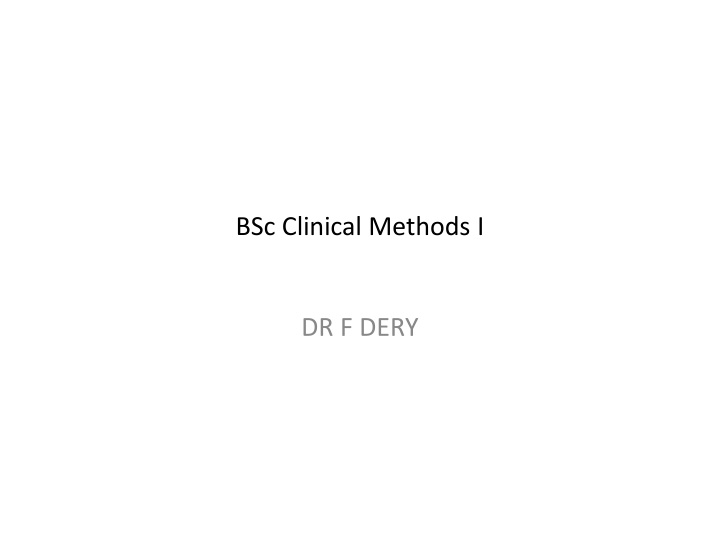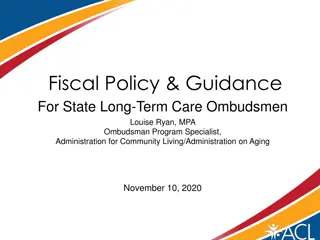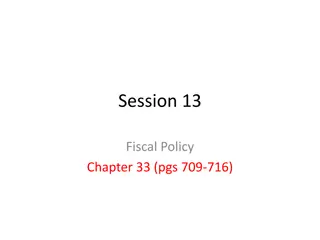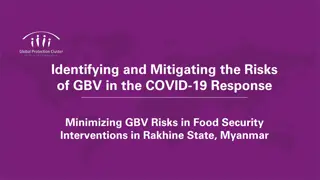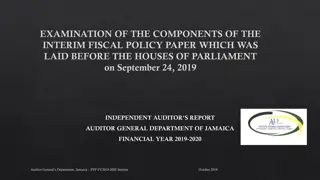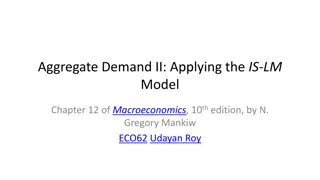Macroeconomic Risks: Impact of COVID-19 on Fiscal Health
The COVID-19 pandemic is causing fiscal stress globally, impacting public finances, government debt, and overall fiscal balance. Explore insights on differentiated economic impacts across Sub-Saharan Africa, fiscal risks analysis, and the elements of a fiscal stress test. Learn how the pandemic affects the economy through containment measures, supply disruptions, and more.
Download Presentation

Please find below an Image/Link to download the presentation.
The content on the website is provided AS IS for your information and personal use only. It may not be sold, licensed, or shared on other websites without obtaining consent from the author.If you encounter any issues during the download, it is possible that the publisher has removed the file from their server.
You are allowed to download the files provided on this website for personal or commercial use, subject to the condition that they are used lawfully. All files are the property of their respective owners.
The content on the website is provided AS IS for your information and personal use only. It may not be sold, licensed, or shared on other websites without obtaining consent from the author.
E N D
Presentation Transcript
BSc Clinical Methods I DR F DERY
Outline - Adults 6-20 - Children 21-27 Physical examination 28-149 - Introduction to Physical Examination 28-34 - General examination 35-57 - Respiratory System 58-83 - Gastro-intestinal System 84-115 - Genito-urinary System 116- 131 - Integumentary System 132-149 Introduction to Clinical Methods 4-5 History taking 6-27
Skills lab(Practical)- techniques of Physical Examination 150-158 - General examination 150-152 - Respiratory System 153-155 - Abdomen(GIT) 156- 158
Making a Diagnosis Diagnosis should precede treatment whenever possible. There are 2 steps in making diagnosis: 1. Observation by clinical methods: History taking Physical examination Ancillary investigations 2. Interpretation of the information obtained
Medical diagnosis is the process of determining which disease or condition explains a person s symptoms and signs and when necessary, results of investigations. Differential diagnosis are various other diseases or conditions which share signs and/or symptoms of the diagnosis. A symptom is a phenomenon that is experienced by the individual affected by the disease- subjective evidence of disease. A sign is a phenomenon that can be detected by someone other than the individual affected by the disease- objective evidence of disease.
History Taking (Adult) The medical history is an account of all medical events and problems the person has experienced bearing on their health past, present and future. It is usual to record the findings of the history taken under the following headings: Presenting Complaint(s) PC History of Presenting Complaint HPC Review of system(s) involved in the presenting complaint- On Direct Questioning- ODQ Review of other systems(Systemic Enquiry) Past Medical History Drug and Allergy History
Family History Reproductive/Obstetric and Gynecological History- any woman of reproductive age Immunization History- in children Social and Occupational History Psychological assessment Summary of the History taken
History Taking 1. Patient- a person receiving or registered to receive medical care. Wash your hands/sanitize hands Introduce yourself: name, job Identify patient with his/her : name, age, occupation Permission: confirm reason for seeing the patient Positioning: sit same level of patient and not behind a desk 2. Presenting complaint (PC) Ask patient to describe their problem using open questions (eg what brought you to the hospital?) The trouble recently (chief symptom); present as list if several symptoms Record the patient own words Do not interrupt the patient first few sentences if possible 3. History of Presenting Complaint (HPC) Ask the patient further questions about the PC into detail Take chest pain: the pneumonic SOCRATES is used Put patient at ease/Introduction (pneumonic WIIPP is used)
Site- where exactly is the pain? Point to the spot Onset- when did it start? Date, time. Was it gradual or sudden, constant or intermittent? Character- what is the pain like? Sharp, burning, tight, etc Radiation- does it move anywhere or stay in one spot? Associations- anything else associated with the pain- vomiting, sweating, etc Time course- does it follow any time pattern? How long did it last?
Exacerbation/relieving factors- does anything make it better or worse? Severity- how severe is the pain? Consider the scale of 1-10. 10 being the worst pain At the end of the HPC you should establish a problem list(systems involved) Body systems- CVS, RS, GIS, GUS, MSK, Endocrine, Integumentary, Nervous.
4. Direct Questioning (DQ) Ask specific questions about the diagnosis/systems you have in mind/systems involved from the history of presenting complaints(HPC) Review of the relevant systems with similar symptoms ( eg cough is in CVS and RS) 5. Systemic Enquiry/Functional enquiry/Review of Systems A brief screen of all the other systems of the body which the patient might have forgotten about and not covered in the HPC and DQ
RS- cough, sputum production, hemoptysis, shortness of breath, wheeze, chest pain CVS- cough, dyspnea, shortness of breath on exertion, paroxysmal nocturnal dyspnea, orthopnea, chest pain, palpitations, ankle swelling, claudication GIT-abdominal pain, nausea, vomiting, constipation, diarrhea, dysphagia, blood loss(hematemesis, malaena), heart burns
GUS- urine frequency, dysuria, polyuria, hematuria, nocturia, menstrual problems, impotence, discharge Locomotor (musculoskeletal)- pains, stiffness, swelling Neurological (nervous)- headaches, weakness, fits, numbness, dizziness, tremors, blackouts, tingling Skin (integumentary)- lumps, ulcers, rashes, itch
Obs/gyne - menses- menarche, LMP, duration of periods- cycle, regularity, pain - Contraception - Gravity/parity - Age of last child, birth weight - Miscarriages, TOP - Complications of pregnancy, labor and puerperium
6.Past Medical History (PMH) Ask patient about all previous medical problems (use the pneumonic MJ THREADS Ca in order not to miss out Myocardial infarction Jaundice Tuberculosis Hypertension Rheumatic fever Epilepsy Asthma Diabetes Stroke Cancer 7. Drug History (DH) All medications that they take: dose, frequency, route and compliance Allergies-reaction to medicines, history of anaphylaxis
8. Social History (SH) His social class, race, religion, marital status His occupation- what his work involves that exposes him to pathogens eg asbestos Alcohol intake- number of units/week Recommended daily intake of 3-4 units for men and 2-3 units for women with 2 alcohol free days per week. 1 unit= 10mls pure alcohol. NB: 5% bottle beer= 1.7 units; 12% wine small glass= 1.5 units; spirits 40%(gin, rum, vodka, whisky) small = 1 unit
Tobacco use- attempt to quantify in pack-years (number of packs of 20 cigarettes smoked per day x number of years smoking) Home situation- accommodation type (house, bungalow, single room), any carers, pets, water, sanitary conditions, able to wash, cook or dress, mobility aids, family support Travel history- recent travel 9. Family History- gather some disease information about the patient s family Heart disease, cancers HPT, TB, DM, genetic conditions Deaths and at what age?
10. Obstetric/gynecological history if a female- menses(cycle, pain, duration, volume), menarche, deliveries & outcome, FP 11. Immunization history if a child- all the antigens 12. SUMMARY Provide a short summary of the history - Name, age - Presenting complaints - Relevant medical history Give a differential diagnosis Explain a brief investigation
As a beginner you need to follow the headings of the history taking but as you gain experience you will know in a given case which part of the history is particularly worth persuing. Examples: If a patient has chest symptoms, the fact that he worked with asbestos factory may be a vital clue , so you will stress more on occupational history If the patient complains are those of anemia, the fact that he has been treated with chloramphenicol may be important, so you stress on drug history A white man with fever, the fact that he travelled to West Africa may be a clue. Stress on social history
When you start with history taking it is wise to make at least some enquiry under all the headings listed. When you get more experience you can know which headings to concentrate on. But in a difficult case it would be unwise to neglect any of the headings listed.
History Taking (Pediatrics) Put child at ease by: - Compliment their clothes or show an interesting toy - Tell child your name and ask theirs - Ask what they had for breakfast - Shake hands with them Talk to the parents Ask for the infant record book- contains information about weight, immunization, development and illnesses in first few years of life Presenting complaint History of presenting complaint
Birth history - Place of birth - Gestation and pregnancy - Birth weight - Delivery - Perinatal events Feeding methods Past medical history Developmental history Drugs and allergies
Family tree- siblings ages, deaths, etc Parental age and occupation Family illnesses and allergies Housing Travel Systemic review
Demonstration of History Taking An imaginary patient(Kofi 30yrs, 60kg, BP110/70, pulse 95/min, RR 24/min, T 38.5) with cough and chest pain- for 3 days PC- cough and chest pain all of 3 days duration HPC- Kofi was apparently well until 3 days ago(onset) he developed a sudden(onset) cough productive of rusty sputum. The cough was throughout both day and night(time course) with no exacerbation or relieving factors. The cough was getting worse so he decided to visit the hospital. The cough was associated with pain which started the same day on the right side of the chest(site) and stabbing in character with a severity score of 7/10. Pain made worse by coughing and relieved at rest ODQ- cough productive of rusty sputum, short of breath, no wheezing and no hemoptysis. (The CVS also give cough so you have to ask questions on that system)- no orthopnea,
No shortness of breath on exertion, no paroxysmal nocturnal dyspnea, no ankle edema. Now you have excluded the CVS as the cause of cough and chest pain because everything was negative for the CVS Systemic/Functional Enquiry- GIT, GUS and locomotor systems- nil of significance, neurological system; there was headache and fever PMHx- nil of significance Drug Hx- taken paracetamol since the onset of the illness 1gm tid and mist expect sed 1 tablespoon tid since onset of illness. He has also taken athemeter/lumefantrine (80/480) 1 twice a day for 3 days. Never had any allergy to any medication in the past.
Social Hx- he is a subsistent farmer, single, takes the local gin a bottle every evening before meals for the past 5 years. Stays in a farm hut near a valley and sleeps on a floor mat. FHx- nil of significance Psychological assessment- well oriented in place , person and time In summary, I present Kofi , a 30 year old subsistent farmer with T= 38.5,P= 95 RR= 24/min, BP= 110/70 and weighing 60kg who presented with a complain of cough, chest pain of 3 days duration. Kofi was apparently well until 3 days ago he developed a sudden onset of cough productive of rusty sputum associated with right chest pain , stabbing in character and worse by coughing with pain severity of 7/10.
Kofi was short of breath and not wheezing or hemoptysis and negative CVS symptoms. Systemic review revealed headaches and fever. He had taken paracetamol and anti- malarial with no effect and no known drug allergy. He is a chronic alcoholic and his living condition exposes him to cold situations. NB In this case you are drawing near a diagnosis(provisional diagnosis) of a right lung disease. If you now add your physical examination and if necessary your investigation you can arrive at a final diagnosis of say right lobar pneumonia.
Physical Examination Physical examination is the evaluation of the body to determine its state of health The techniques include the following in each system examination: Inspection(looking) Palpation(feeling) Percussion(tapping) Auscultation(listening with stethoscope) The format might change depending on the condition you are dealing with.
Before commencing a physical examination: Always stand at the patient right hand side Introduce yourself to the patient Explain what you would like to do Obtain a verbal consent Ensure patient has adequate privacy to undress Make sure you will not be disturbed Position the patient in supine position with head and shoulders raised at 45 degrees(put a pillow behind the shoulders).
Physical Examination Order For Routine Examination General examination Systemic examination - Cardiovascular - Respiratory - Gastrointestinal/genitourinary - Neurological - Endocrine - Musculoskeletal - Integumentary as follows: 1. Inspection- look 2. Palpation- feel 3. Percussion- tapping with a finger over the other placed over a surface 4. Auscultation- listen with a stethoscope
Physical Examination Instruments/Devices Thermometer- for measuring temperature Sphygmomanometer- for measuring blood pressure Stethoscope- for listening to body sounds- heart, lungs, thyroid, intestines as well as flow in arteries and veins Otoscope- to view ear canal and tympanic membrane Ophthalmoscope- to examine the interior structures of the eye Percussion(patella) hammer- used to test neurologic reflexes
Penlight- provides light to examine specific area of the body Nasal speculum- for inspection of the lining of the nose, nasal membranes and septum Laryngeal mirror- to examine larynx and other areas of the throat Audioscope- used to screen for hearing loss Tuning fork- to test patient hearing The examiner s hand( methods of palpation)
- Finger tips- for skin texture(smooth, rough), swelling, pulsations - Fingers and thumb (grasping action)- to determine position, size and consistency of body part - Front of the fingers- for light palpation, deep palpation, light ballottement and deep ballottement - Back of fingers and hand-to check body temperature - Side of hand (palmar)- to check vibrations in the body- vocal fremitus, fluid thrill, heart thrill
Areas that are Commonly Auscultated Respiratory system (lungs)- listen for normal breath sounds and abnormal breath sounds Heart- listen for normal and abnormal heart sounds (murmurs)- caused by turbulent blood flow through the heart valves Abdomen- listen for normal and abnormal bowel sounds Major vessels (carotid artery, abdominal aorta)- for bruits (an audible vascular sound associated with turbulent blood flow) Thyroid gland- for bruits
Do a General Examination This cuts across all Systems To begin, use the acronym WIIPPPPE Wash your hands Introduce yourself Identity of patient (confirm) Permission (consent and explain examination) Pain (any pain) Position patient at 45 degrees (pillow behind shoulders) Privacy Expose chest to waist
Stand on right side of patient at the foot end of the bed. How sick is he/she?- ill looking or not ill looking Pattern of breathing- normal, kussmaul (slow deep respiration), cheyne stokes(alternating periods of cessation of respiration & hyperventilation) Nutritional status/Shape-obese, cachetic. The body mass index(BMI) is a useful estimate of body fatness. BMI= weight(kg)/height(square metres)
19-25= normal 25-30= overweight 30-40= obese >40= extreme obesity Behavior- oriented in place, person and time Any pedal swelling/pitting- press gently on both legs above the medial malleolus with both thumbs for a while & see if a dent. Any varicose veins?- enlarged, swollen and twisted veins commonly appearing in legs and feet Then move up a bit and hold the hand
Hydration status - Skin turgor pinch fold of skin on back of hand or forearm for a few seconds and let it go- prompt return, slowly or vey slowly - Capillary refill- press pulp of thumb for 5secs and release and see refill; if <2secs normal (capillary refill) - Pulse rate- tachycardia Check for palmar pallor- compare yours with the patient Palmar erythema (red palms) Check for peripheral cyanosis- see if the finger nails are bluish Splinter hemorrhages- tiny ,longitudinal streaks hemorrhages Check for choilonykia- spoon shaped nails. Depuytren s contracture- thickening and contraction of the palm
Check for clubbing- raise the finger to level of your eye to see if the angle at the base of the nail is lost (Lovibond angle) OR lost diamond window between opposed nail beds- back-to- back (Schamroth s sign- most reliable) Stages of Finger Clubbing - Increase fluctuation of nail bed - Loss of normal angle between nail bed and cuticle - Increased longitudinal curvature of nail - Thickening of whole distal finger - Shiny and striated appearance of nail and skin Then move up to the head Face- for sunken eyes (dehydration)
Check for jaundice- stabilize the upper eye lid with one finger & let patient look at the other palm as you move it towards the abdomen and vice versa. This exposes the white of the eye for you to see if it is yellow Let patient open mouth- check for central cyanosis(bluish tongue), dehydration(dry tongue and mucous membranes) and pallor on the protruded tongue Palpate for enlarged lymph nodes- neck, axillae, inguinal, popliteal. Check vital signs if not already done (temp, pulse, respiratory rate, BP, ?blood glucose)
Temperature Rectal readings are higher than oral readings, while armpit readings tend to be lower. Normal body temperature will vary depending on the following factors: - Age and sex - Time of the day- lowest in the morning and highest late afternoon - Food and fluid intake - Stage in monthly menstrual cycle in females
Normal Ranges of Body temperature 0-2 years 3-10 years 11-65 years 65 years and over Oral 35.5- 37.5 35.5- 37.5 36.4- 37.6 35.8- 36.9 Rectal 36.6-38.0 36.6- 38.0 37.0- 38.1 36.2- 37.3 Armpit 34.7- 37.3 35.9- 36.7 35.2-36.9 35.6- 36.3
Vital Signs (TPR, BP) - Hypothermia - <35 - Febrile - >37.2 - hyperpyrexia- >41.6 Pulses palpable - Radial artery- just medial to the radial styloid process - Brachial artery- medial side of the antecubital fossa; medial to the tendinous insertion of the biceps - Carotid artery- from the larynx laterally backwards medial to the sternomastoid
- Femoral artery- midway between the pubic tubercle and the anterior superior iliac spine - Popliteal artery- centre of popliteal fossa; press with pressure with tip of fingers - Posterior tibial artery- posterior and inferior to the medial malleolus - Dorsalis pedis artery- superior surface of the foot between the bases of the 1stand 2ndmetatarsals
Express pulse in beats per minute. Count for 1 full minute and not 30 secs x 2 or 15 secs x 4 Normal rate is 60-90bpm. <60bpm is bradycardia, >100bpm is tachycardia age heart rate <1yr 120-160 1-3yrs 90-140 3-5yrs 75-110 5-12yrs 75-100 12-16yrs 60-90
Check the rhythm- is it regular, regularly irregular, irregularly irregular Check the volume Check the character(waveform) - Pulsus alternans- alternating strong and weak pulse- LVF - Pulsus paradoxus- pulse weaker during inspiration- cardiac tamponade, status asthmaticus - Collapsing pulse- suddenly hits your fingers and falls back quickly- aortic regurgitation, patent ductus arteriosus - Radio-femoral delay- the pulses palpated together and delay in the pulsation reaching the femoral artery point to coarctation of aorta - Radio-radial delay point to aneurysm at aortic arch or subclavian artery stenosis - Bounding-sepsis, carbon dioxide retention, liver failure - Small volume-shock, pericardial effusion, aortic stenosis
Respiratory rate- count the breathing in and the breathing out as 1 cycle age respiratory rate <1yr 30-60 1-3yrs 24-40 3-5yrs 18-30 5-12yrs 18-30 12-16yrs 12-16
Blood Pressure(BP) - Use the right cuff for the right patient- we have child, standard adult and large adult cuffs - Patient should be relaxed - Monitor the radial pulse and inflate the cuff until the radial pulse is no more palpable - Listen over the brachial artery with the diaphragm or bell of the stethoscope - Note the point at which the pulsation is audible(korotkoff phase I)- record as systolic BP. Systole= heart contracts - Note the point at which the sounds disappear(korotkoff phase V)- record as diastolic BP. Diastole= heart relaxes - Record the BP as systolic/diastolic
Age/yrs Up to 1 75/50 90/60 1-5 80/55 95/65 6-13 90/60 105/70 14-19 105/73 117/77 20-24 108/75 120/79 25-29 109/76 121/80 30-34 110/77 122/81 35-39 117/78 123/82 min. Normal max. 110/75 110/79 115/80 120/81 132/83 133/84 134/85 135/86
40-44 112/79 125/83 45-49 115/80 127/84 50-54 116/81 129/85 55-59 118/82 131/86 60-64 121/83 134/87 137/87 138/88 142/89 144/90 147/91
